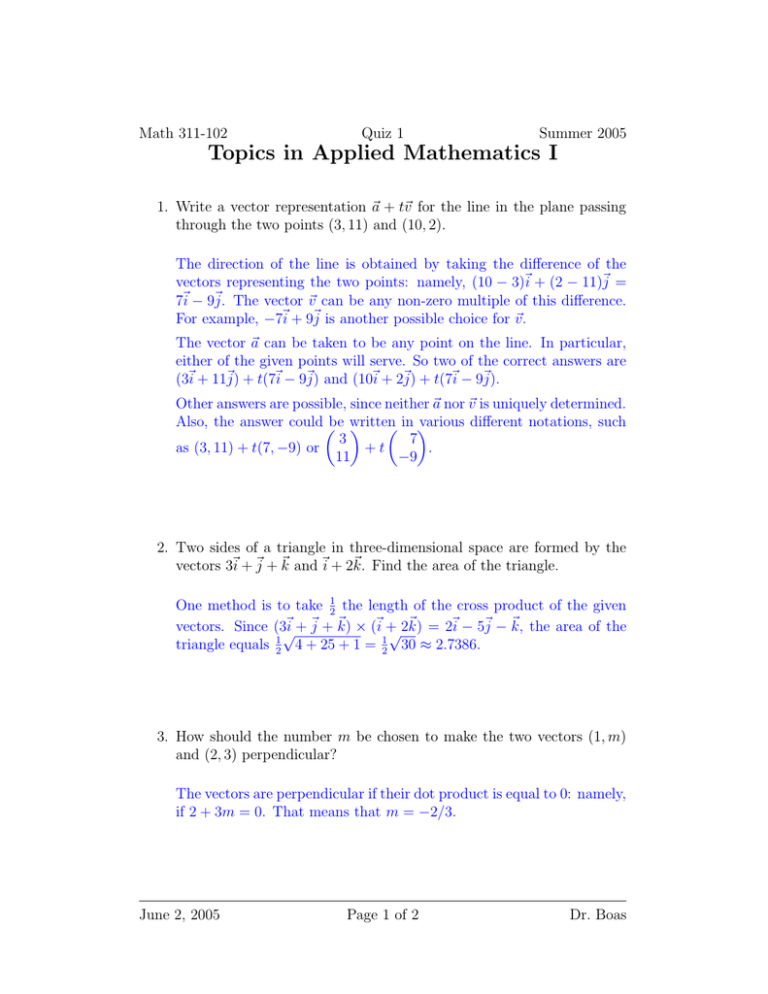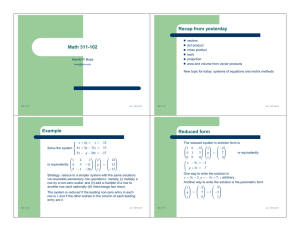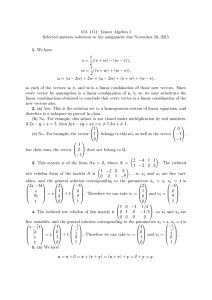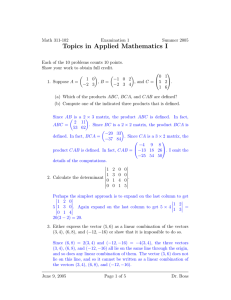Math Quiz: Vectors, Matrices, and Linear Combinations
advertisement

Math 311-102 Quiz 1 Summer 2005 Topics in Applied Mathematics I 1. Write a vector representation ~a + t~v for the line in the plane passing through the two points (3, 11) and (10, 2). The direction of the line is obtained by taking the difference of the vectors representing the two points: namely, (10 − 3)~i + (2 − 11)~j = 7~i − 9~j. The vector ~v can be any non-zero multiple of this difference. For example, −7~i + 9~j is another possible choice for ~v . The vector ~a can be taken to be any point on the line. In particular, either of the given points will serve. So two of the correct answers are (3~i + 11~j) + t(7~i − 9~j) and (10~i + 2~j) + t(7~i − 9~j). Other answers are possible, since neither ~a nor ~v is uniquely determined. Also, the answer could µbe written various different notations, such ¶ µ in ¶ 7 3 . +t as (3, 11) + t(7, −9) or −9 11 2. Two sides of a triangle in three-dimensional space are formed by the vectors 3~i + ~j + ~k and ~i + 2~k. Find the area of the triangle. One method is to take 12 the length of the cross product of the given ~i + ~j + ~k) × (~i + 2~k) = 2~i − 5~j − ~k, the area of the vectors. Since (3√ √ triangle equals 21 4 + 25 + 1 = 21 30 ≈ 2.7386. 3. How should the number m be chosen to make the two vectors (1, m) and (2, 3) perpendicular? The vectors are perpendicular if their dot product is equal to 0: namely, if 2 + 3m = 0. That means that m = −2/3. June 2, 2005 Page 1 of 2 Dr. Boas Math 311-102 Quiz 1 Summer 2005 Topics in Applied Mathematics I 0 0 2 4. Find a reduced matrix equivalent to the matrix 2 0 0. 0 0 3 0 0 1 Dividing each row by a suitable constant reduces the matrix to 1 0 0. 0 0 1 Subtracting the top row from the bottom row reduces the matrix to 0 0 1 1 0 0. This matrix is a correct answer, and so is any of the six 0 0 0 permutations (rearrangements) of the rows. 1 0 0 The standard “echelon form” of the answer is 0 0 1. 0 0 0 5. Either express the vector (1, 2, 3) as a linear combination of the vectors (1, 0, 1), (1, 1, 0), and (1, 1, 1) or show that it is impossible to do so. 1 1 1 1 The goal is to solve x 0 + y 1 + z 1 = 2 for x, y, and z. 3 1 0 1 Subtracting thesecond row fromthe first row gives the equivalent sys1 0 0 −1 tem x 0 +y 1 +z 1 = 2. Subtracting the first row from 1 0 1 3 −1 0 0 1 2. Subtracting the the third row gives x 0 +y 1 +z 1 = 0 0 1 4 1 0 0 −1 third row from the second row gives x 0 +y 1 +z 0 = −2. 0 0 1 4 1 1 1 1 So x = −1, y = −2, z = 4, and 2 = − 0 − 2 1 + 4 1. 3 1 0 1 Other solution strategies are possible, but the final answer is unique. June 2, 2005 Page 2 of 2 Dr. Boas





